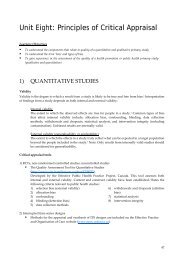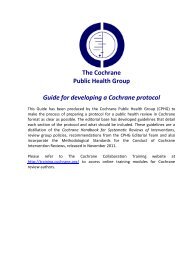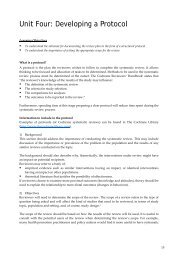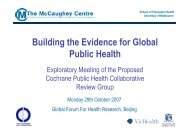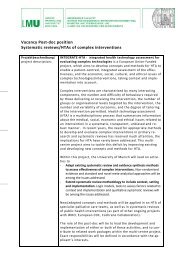Train the Trainer Course book - Cochrane Public Health Group
Train the Trainer Course book - Cochrane Public Health Group
Train the Trainer Course book - Cochrane Public Health Group
You also want an ePaper? Increase the reach of your titles
YUMPU automatically turns print PDFs into web optimized ePapers that Google loves.
Unit Eleven: Writing <strong>the</strong> Systematic<br />
Review<br />
Learning Objectives<br />
To understand <strong>the</strong> requirements to publish a systematic review<br />
To be familiar with <strong>the</strong> criteria that will be used to judged <strong>the</strong> quality of a systematic review<br />
When o<strong>the</strong>rs read your review <strong>the</strong>y will be assessing it for <strong>the</strong> systematic manner in which bias was<br />
reduced. A useful tool to assess <strong>the</strong> quality of a systematic review is produced by <strong>the</strong> Critical<br />
Appraisal Skills Programme (CASP) and can be found at<br />
http://www.phru.nhs.uk/~casp/appraisa.htm (provided overleaf). It is useful to keep this tool in mind<br />
when writing <strong>the</strong> final review.<br />
Reviewers may consider submitting <strong>the</strong>ir review to:<br />
1) The <strong>Cochrane</strong> Collaboration – must go through <strong>the</strong> <strong>Cochrane</strong> editorial process<br />
2) The Database of Abstracts of Reviews of Effects (DARE) – this database is held by <strong>the</strong><br />
University of York - http://www.york.ac.uk/inst/crd/crddatabases.htm<br />
3) The Evidence for Policy and Practice Information and Co-ordinating Centre (EPPI-Centre) to<br />
be included in The Database of Promoting <strong>Health</strong> Effectiveness Reviews (DoPHER) -<br />
http://eppi.ioe.ac.uk<br />
4) A published journal relevant to <strong>the</strong> topic of <strong>the</strong> review.<br />
Two sets of guidelines are available for reviewers wishing to submit <strong>the</strong> review to a published<br />
journal. Reviewers should read <strong>the</strong> guidelines relevant to <strong>the</strong> study designs included in <strong>the</strong> review:<br />
1) Systematic reviews of RCTs:<br />
Moher D, Cook DJ, Eastwood S, Olkin I, Rennie D, Stroup DF. Improving <strong>the</strong> quality of reports of<br />
meta-analyses of randomised controlled trials: <strong>the</strong> QUOROM statement. Quality of Reporting of<br />
Meta-analyses. Lancet. 1999 Nov 27;354(9193):1896-900.<br />
2) Systematic reviews of observational studies:<br />
Stroup DF, Berlin JA, Morton SC, Olkin I, Williamson GD, Rennie D, Moher D, Becker BJ, Sipe TA,<br />
Thacker SB. Meta-analysis of observational studies in epidemiology: a proposal for reporting. Metaanalysis<br />
Of Observational Studies in Epidemiology (MOOSE) group. JAMA. 2000 Apr<br />
19;283(15):2008-12.<br />
ADDITIONAL READING<br />
Oxman AD, Cook DJ, Guyatt GH for <strong>the</strong> Evidence-Based Medicine Working <strong>Group</strong>. Users’ guide to<br />
<strong>the</strong> medical literature. VI. How to use an overview. Evidence-based Medicine Working <strong>Group</strong>. JAMA<br />
1994;272:1367-71.<br />
EXERCISE<br />
1. Critically appraise in small groups “DiCenso A, Guyatt G, Willan A, Griffith L. Interventions to<br />
reduce unintended pregnancies among adolescents: systematic review of randomised controlled<br />
trials. BMJ 2002;324:1426-34”, using <strong>the</strong> 10-question CASP checklist.<br />
133



